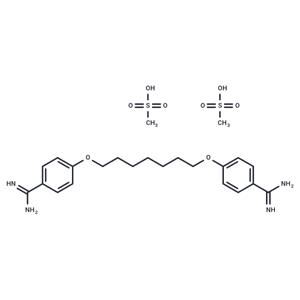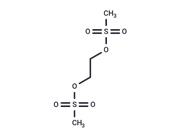| Name | Heptamidine dimethanesulfonate |
| Description | Heptamidine dimethanesulfonate (SBi4211 dimethanesulfonate) serves as a potent inhibitor related to Pentamidine, targeting the calcium-binding protein S100B with a dissociation constant (Kd) of 6.9 µM. It demonstrates specificity by preferentially killing melanoma cells overexpressing S100B compared to cells lacking this protein. Additionally, Heptamidine is employed as a valuable research tool in the study of Myotonic dystrophy (DM). |
| In vitro | Heptamidine rescues the mis-splicing of minigene reporters in a HeLa cell DM1 model (EC50: 15 μM). Heptamidine (20 μM) does not decrease CUG levels significantly when compares to Propamidine and Pentamidine, and exhibits cytotoxic at concentrations above 17.5 μM in HeLa cells expressing 960 CUG repeats [2]. |
| In vivo | Heptamidine (i.p.; 20 or 30 mg/kg; 7 days) causes a dose-dependent reduction of exon 7a inclusion in HSALR mice, returning to wild type levels (6±1%) when at 20 mg/kg dose, the myotonia is reduced from grade 3 to grade 1 (occasional myotonic discharge) or grade 0 at both 20 or 30 mg/kg [2]. |
| Storage | Powder: -20°C for 3 years | In solvent: -80°C for 1 year | Shipping with blue ice/Shipping at ambient temperature. |
| Solubility Information | 10% DMSO+40% PEG300+5% Tween 80+45% Saline : 2 mg/mL (3.57 mM), Sonication is recommended.
H2O : 8.33 mg/mL (14.86 mM), Sonication is recommended.
DMSO : 70 mg/mL (124.85 mM), Sonication is recommended.
|
| Keywords | SBi-4211 | SBi4211 | SBi 4211 | S100B | Myotonic | melanoma | Inhibitor | inhibit | Heptamidine dimethanesulfonate | Heptamidine | HeLa | dystrophy | cell | cancer | calcium-binding protein S100B | Calcium-Binding |
| Related Compound Libraries | Bioactive Compound Library | Inhibitor Library | NO PAINS Compound Library | Bioactive Compounds Library Max |

 United States
United States






